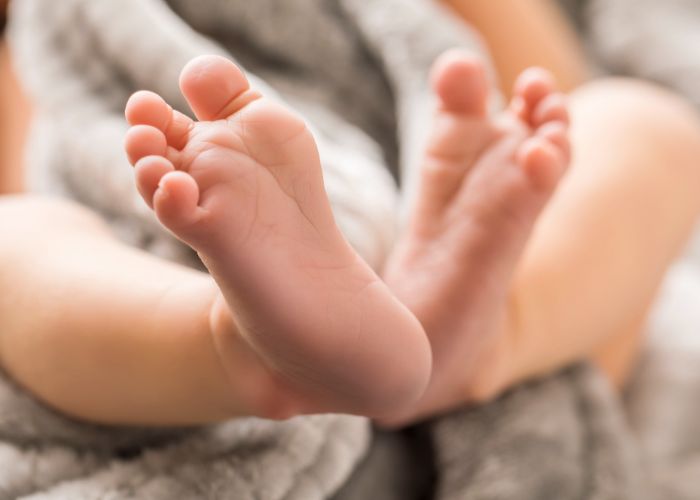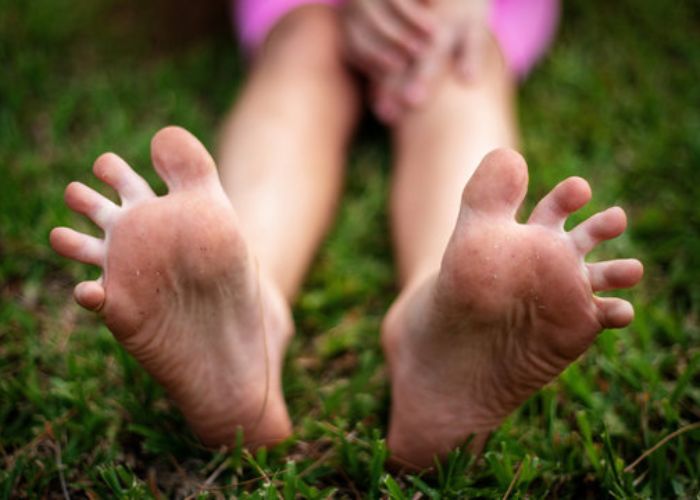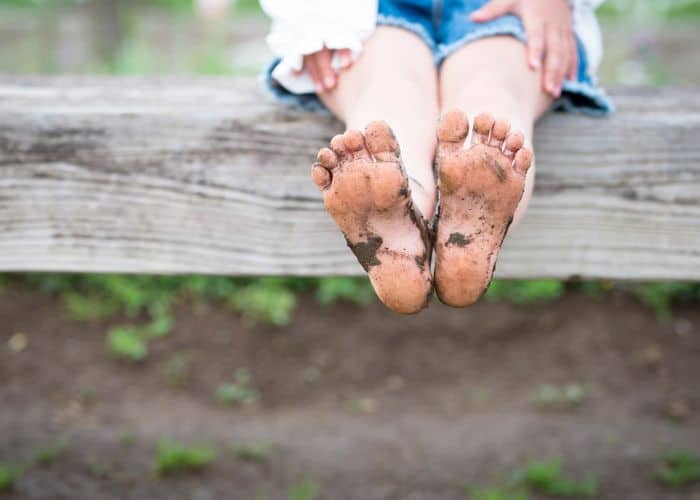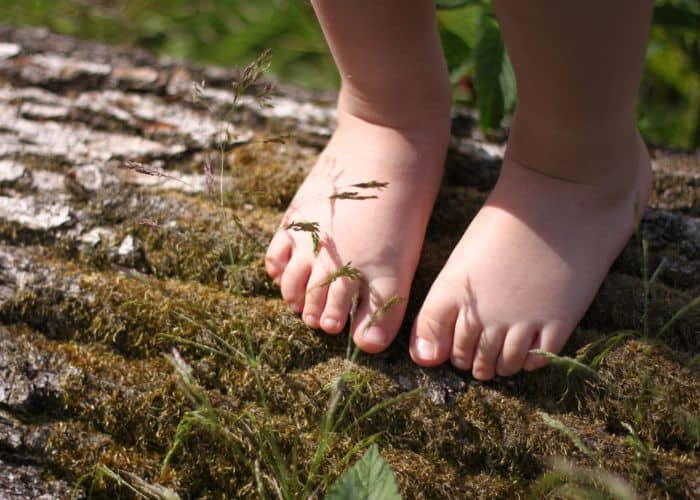Have you ever noticed how babies kick off their shoes and socks any chance they get?
Well, it is not a coincidence…
The human foot is a unique, amazing marvel of bio-engineering. Our foot is a complex mechanical structure made up of 26 bones, 33 joints, and over 100 muscles, ligaments and tendons. Did you know that there are more than 200,000 nerve endings in the sole of one foot? That is more than anywhere else in your body…

Our foot is not only enable us to walk and run but gives a myriad of sensory information about our environment. The foot is one of the body`s most sensitive area to sensory stimulation. Sensory information from the feet not only protects from injury, but the nerve impulses received by the brain, will then in turn send messages to the muscles through the nerves to make subtle adjustments in the gait to protect bones and joints and to ensure efficient movement.
Research shows that it’s best for kids to be barefoot as much as possible
The human foot at birth is not a miniature version of an adult foot, it’s quite different that that!
At birth the foot contains no bones, consists of a mass of cartilage, which over a period of years become the bones of the adult human foot. This process is not complete until the late teens, so it is crucial to pay attention to feet health from an early age until the late teens. Children`s feet are like a plastic structure which can be moulded in any shape…
Research shows that it’s best for babies (and older kids, too) to be barefoot as much as possible. A comprehensive study The Foot published in the Podiatry Journal in 2007 suggests that structural and functional changes can result from the foot having to conform to the shape and constriction of a shoe, rather than being allowed to develop naturally. And the younger the foot, the greater the potential for damage.

According to the Institute of Chiropodists and Podiatrists, throughout the first years, babies’ feet are quite different in many ways from those of an adult. They are a different shape; wider in the forefoot and narrow at the heel with the toes often being curly. The babies’ feet consist of nothing more than cartilage, hence soft and pliable. This is why small children can do things to their feet without any harm at all, which would certainly injure an adult. The child’s feet gradually develop throughout the early years, becoming basically bony by the age of 7-8 years, at which point the toes have usually straightened.
Being barefoot, even before standing, teaches babies about their bodies and their surroundings. Bare feet against various surfaces exposes babies to different textures, temperatures, and opportunities to feel with their feet and toes hence getting sensory information. This helps proprioception and more importantly adds to brain and nervous system development.

The children`s feet are flat and broad, designed to function barefoot. In the early stages of walking, shoes are unnecessary, in fact, it is desirable to allow to walk barefoot and thus strengthen the muscles in the feet. Therefore, we strongly advise to ditch the cute baby shoes and let your child learn to walk barefoot.
It is very important to let your baby’s feet develop as naturally as possible. Indoors and outdoors, when the weather is warm enough you should encourage your baby to exercise barefoot, free from the constrictions of footwear.
Despite how irresistible tiny little sneakers are, there’s no scientific evidence that infants need to wear shoes once they’ve learned to walk. In fact, the opposite might be true; going shoeless helps a just-toddling toddler improve her balance, strength, and coordination.
Why Barefoot is Best for Kids?
Being barefoot allows for optimal foot development, improves agility, strengthens children’s awareness and balance on various surfaces, and boosts sensory development.
Optimal foot development. Most children’s shoes (especially if the narrow, tight ones with inflexible sole can interfere with foot development because the foot conforms to the shoe instead of forming naturally. Being barefoot allows the natural development of ligaments, muscles and joints.
Improved agility. When toddlers walk barefoot they tend to look up because the information they receive through their feet orients them and makes them feel secure. Shoes block such information and as a result, toddlers wearing them tend to look down and are more apt to topple over. Many shoes also restrict toe spread, which helps tots stay balanced. Barefoot steps also boost coordination because they send messages to a child’s brain about how to organize his movement patterns and effectively navigate his body through space.
Promoting awareness. Being barefoot not only frees children to look up and around rather than at the floor, but also helps them learn to safely traverse different surfaces. Walking and running barefoot on hard floors, sand, grass, mud and the like gives children confidence to manoeuvre their bodies in different settings. Research has even suggested that being barefoot correlates with being less prone to injury.
Sensory stimulation sensory motor development. Sensory stimulation of the children`s feet caused by different terrains, textures, and temperatures is known to be essential to develop all other sensory systems in the body including proprioception– the awareness of the position and movement of the body. Barefoot tummy time and crawling allows full freedom to use feet and toes for movement and sensory exploration too!

Being Barefoot- The Problems
Barefoot shoes for children are a great option to protect the feet in unrestrictive footwear, however, we should still give our children, especially our infants and toddlers, plenty of time to spend barefoot to ensure optimal feet development.
Unfortunately, it isn’t always safe for a child to be barefoot. We wouldn’t want our little one to step on glass on a walk to the park.
Admit it… you might be worried and might even give the side-eye to a parent whose child is running around barefoot without any protection on his feet. After all, what if he steps on a rock or, worse, a piece of glass?
In an ideal world, our kids could all walk and play around barefoot. You have to consider the environment the child is in. Let’s be honest. Do you want your child walking on the streets or in the park barefoot, where there might be dog poo, dirt and possible hazards like glass? Even the biggest proponents of going barefoot understand that there are some places where kids probably should wear shoes, though it’s worth noting that the more a child goes barefoot, the more natural protection their feet will have from hazards—though, probably not nails or screws.

The Solution
City sidewalks and dirty grounds aren’t barefoot-friendly, but warm homes are! Our play mats let you to bring the nature`s surfaces inside the safety of your home.
Our play mats are engineered to specifically replicate natural surfaces hence providing the sensations in the children’s feet felt in nature. These soft and hard interlocking mats feature the textures of grass, pebbles, seashells, forests giving the pleasures and benefits of walking barefoot over real surfaces. The purpose of our sensory floor mats is to give children a taste of walking in different natural textures in safe environments.
Walking on our sensory play mats is great for training for standing, walking and good balance. They are contributing to the proper development of a child’s foot muscles and joint mobility resulting a healthy foot. The tactile sensory input of the various uneven textures of our sensory mats also massage the kids’ feet and stimulate their senses. Muffik`s play mats are great for sensory play and also encourages the development of cognitive growth, fine and gross motor skills and helps to build nerve connections in the brain. Our interlocking floor puzzles are fun, inspire imagination and creativity of the children as well!